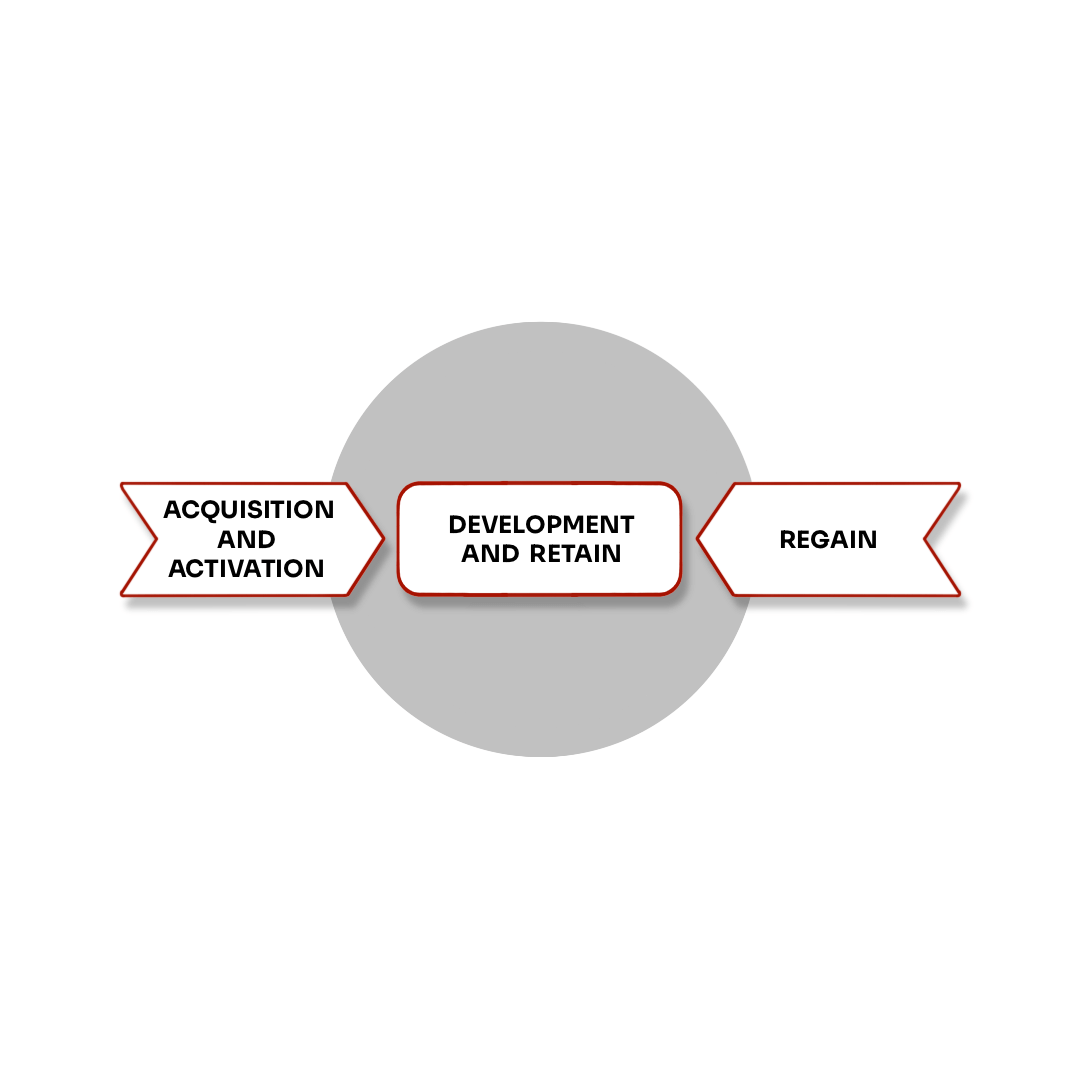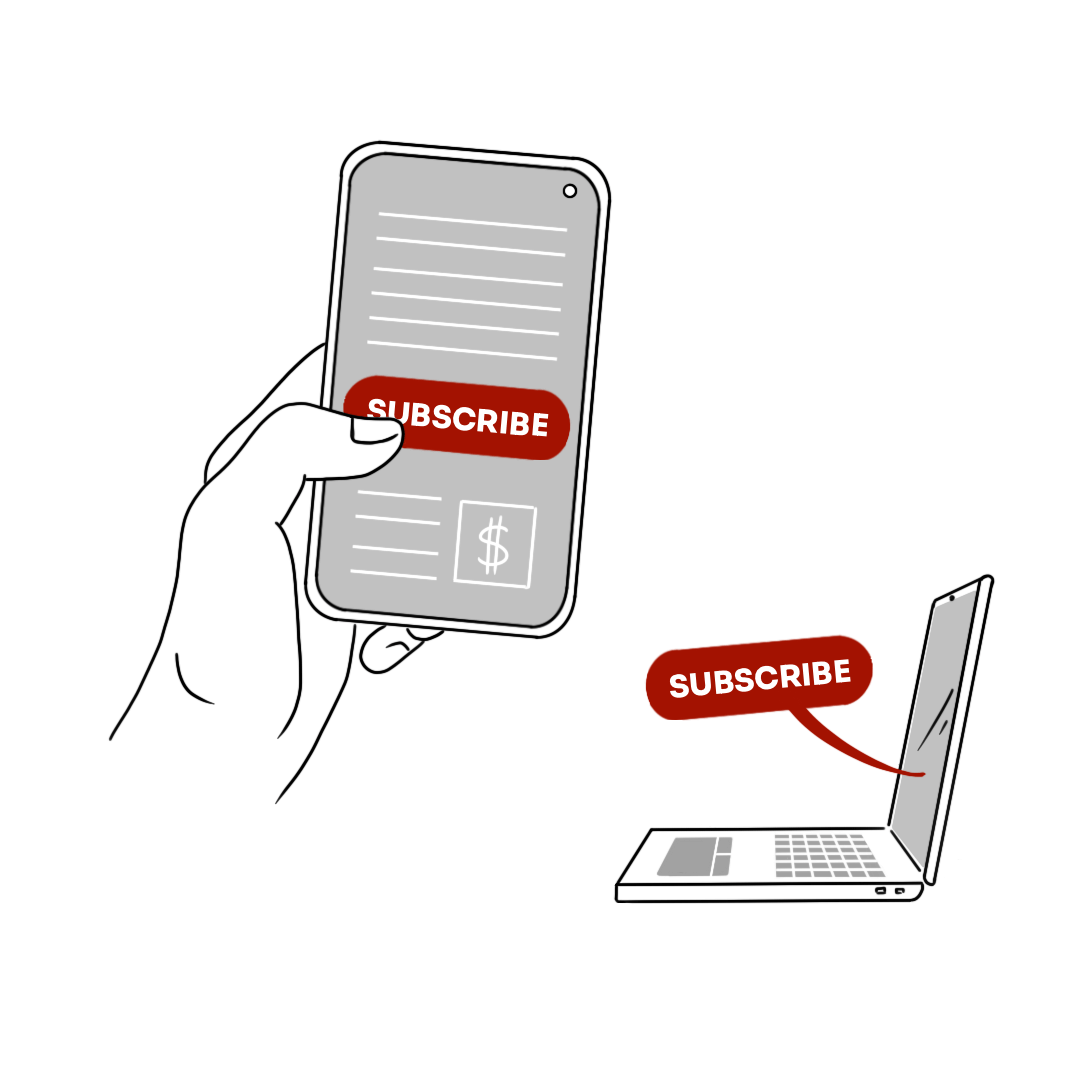Growing Your Business Depends on Your Customers
Probably, you can imagine a company without logistics. Or (hold on tight and take a deep breath), without a marketing department. Nowadays, some firms even decide to operate without headquarters or offices. But try to imagine the company without customers. Maybe such companies exist, but they are probably not the most successful ones.
Customers are the biggest assets of a company. Its revenue depends on how many people decide to exchange their money for offered products or services. So you can say that your company’s value depends on your customers. The only way to grow your business is whether to acquire and activate new customers, develop and retain active ones, or regain inactive ones.
As simple as it is. You either grow your customer base, stimulate existing value, or drive back those who stopped visiting you, which is described in the model below.

In real life, you have to work with these three streams simultaneously, but your focus should be all about maximising value per active customer and making sure that they stay active. Therefore, in the model centre, you can find the Develop & Retain as it is the phase where the most value (sales & engagement) is generated. Here you have the opportunity to build a deep, long-term relationship, drive engagement and boost customer lifetime value. From this perspective, lefthand and righthand phases may look “supportive”. The base of active customers is naturally eroding with time, negatively impacting your sales results. This fact points out the need for the ongoing “recruitment” of new customers and regaining the inactive ones.
Customer acquisition and activation phase - who do you invite?
Two objectives for customer acquisition:
- Get the prospect with the highest propensity to become a customer;
- Get to know your new customer and profile them as soon as possible.
Before you get a chance to develop the value of every single customer, you have to first acquire and activate them to make the first initial purchase with you. In a perfect world, everyone can become your customer, and you have the power to invite everyone. But in reality, you will always face some limitations, so what you should do? The only reasonable answer is: I’m looking for the ones with the highest propensity to stay and grow my business. Probably, you’ve heard the old mantra that it’s cheaper to keep an existing customer than to acquire a new one. Well, it depends… People are different, so they behave differently, and your ability to control their doings in the future is limited. But you can control who you invite to your brand. By defining what your “dream customer” looks like, where you can find them, and their needs, you can design your acquisition strategy and target the communication toward the selected audience.
For this reason, acquisition strategy determines the further stages. If you fail or miss the target, the retention cost can become impossible to bear, and you will become addicted to the never-ending acquisition.
But there is a catch. Your competition probably chases the same people, which impacts the cost of acquisition and makes it more expensive. Most likely, you’re fishing in the same ocean, and only the smartest can win. The old and experienced fisherman knows exactly what fishes he’s looking for before going to the sea. He knows where to find them and how to recognise the most valuable pieces. He works smart, not necessarily hard. The same applies to you, as a marketer, before you start, should define your perfect candidates for customers, learn how to recognise them on the early stage, which are the most promising, and how much you’re able to invest in this relationship.
Develop and retain active customer
Two objectives for the develop & retain phase:
- Keep customers active by giving them a constant reason to be engaged and leaving traces;
- Grow their value for your brand (purchase frequency and/or basket value).
Which, as a result, will give you higher Customer Lifetime Value.
Starting from the second objective: it’s like in the chain petrol station, where shopkeeper always asks you:
Do you want windshield washer fluid?
Do you want coffee or hod-dog?
In marketing jargon, we call it up-sell and cross-sell
Excellent starting point. Acting on the most recent customer purchase, especially when receiving payment, when the customers have their wallets wide open – it is a great way to drive additional sales. No matter if it happens at a physical shop counter, or in an online basket. It’s a very powerful tool, very simple to implement. But, unfortunately, too often in a poor way. How often have you felt that offering this coffee or hot dog is a hassle for the shopkeeper, not “adding value-to-your-satisfaction” hot beverage? The same applies to online. When you have to close all pop-ups and confirm a dozen times, you certainly don’t need additional products.
And because brands do it in a generic, not engaging way, it allows you to act differently. The key word here is personalisation. Connecting the previous customer purchases and suggesting something that matches them. As hard to achieve, you can look for an easier and down-to-earth solution, like rotating different offers seasonally (coffee during the winter, cold drink during the summer). You see the logic. If you can’t be relevant to every single customer, at least be relevant to the context.
Another popular technique is to act in the post-purchase phase. As a customer, you can experience this when random laptop batteries chase you a week after you bought one for your youngest kid’s old computer (it’s like you’re buying laptop batteries every week, what the odds?). Of course, this technique is less creepy most of the time, and you can probably think about the different brilliant ways of post-purchase communication that you received. I’m a big fan of staying in touch with customers when they become owners of your products, as it’s a great moment to deepen the relationship, boost the experience or get feedback. But expecting that this action becomes a shower of money may be delusive. Firstly, there are always fewer people on the bottom of the conversion funnel than on the very top. So your audience (or target group) is relatively smaller. But the real problem is that you try to impact customer behaviour at the moment when they have made all the important decisions. Adding 100 euro more to the 1000 euro basket sound like less money than taking 100 euro out of the pocket a couple of days later, even though it’s still the same hundred euro.
Retaining and developing your customer value requires something more than a good deal on the checkout. Too much focus on transactions may reduce the value in the long term. It’s like assuming that a sports career starts from winning a medal at the Olympics Games, not when you were six and your dad was waking you up every day at dawn for the training. Similarly to customers, most work happens days, sometimes even weeks or months before the purchase. Along comes the engagement — usually the highest before the decision. Many times it is at this phase that the customers are the most active. They are open to your communication, to friends’ suggestions. Imagine two stereotypical situations: a bloke before buying a car and a gal before purchasing a wedding dress. Can you be more excited? For marketers, it means constantly working with the purchase intent. Build a system that can interpret all the traces your customers spread in all channels and provide relevant dialogue to help them achieve their goals. If you only focus on transactions, you will be sometimes many months too late.
Regain inactive customer
Two objectives for the regain phase:
- Define the “inactive customer” and build relevant strategies;
- Get back the inactive customers with the propensity to stay (continue purchases).
To some extent, the regain phase is the mirror reflection of the acquisition. Still, your goal is to recognise which of your valuable customers are at risk of abandoning you and what is the opportunity to drive them back.
You may laugh. How hard it can be to recognise inactive customers? Frankly speaking, it may be at least confusing, and setting a clear definition is vital. You may have customers, who don’t buy from you but still interact with your communication (e.g. open and click on an email from you). Will you call them “inactive”? Or maybe you have customers who still visit your website, checking the products, but still do not buy? How to call these guys? Active or not? Or how many months have to pass before you realise that this customer is lost? A clear definition will help you to track the early signals. If a customer fell out from the pattern, you will be the first to know. I saw way too often the marketers waiting until the end of the year to launch an extensive regain campaign. No wonder the effect of such campaigns can be compared to the resuscitation of an ice skater fished out from the lake in June. Can you be more dead?
As regaining customers is a mirror reflection to the acquisition, it should be performed like acquisition: as an everyday process. People everlastingly stop buying, but many of them were active long enough that so you have some history together. It should help you to understand why and how to bring them back. And this leads us to the final thoughts: you can’t keep all customers. The primary reason is a natural erosion of your customer base, e.g. customers naturally leave your category or your offer is not wide enough. So instead of forcing people to stay, by giving them more of what they don’t want (e.g. more offers, higher discount), it’s better to invest in new products or new services, that may help you retain customers before they leave you. Secondary (but probably equally important), is the cost of keeping customers. How much you’re ready to pay to keep the relationship? You have to know, what is the potential value of regaining the customer. If the cost of regaining is higher than the possible benefits, is it worth it? Sometimes brands focus too much on keeping customers for any price. And then they do have not enough resources to drive new on or focus on proper development. It’s similar to the one when you focus too much on the member acquisition. If you are interested in learning more about customer churn, you can find it on my blog.
Hopefully, you’ve enjoyed the reading, and next time, when talking about your customers, you will be able to differentiate where they are and how to build your strategy around them.







